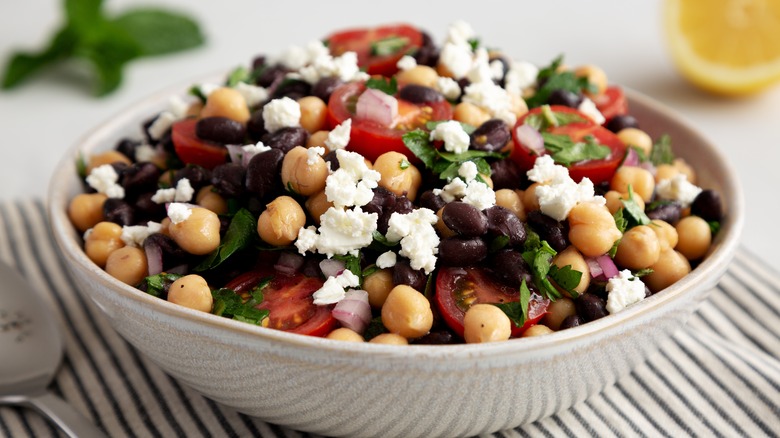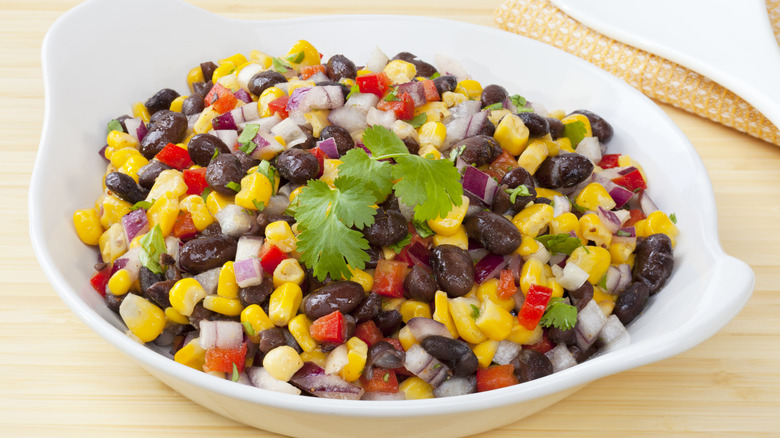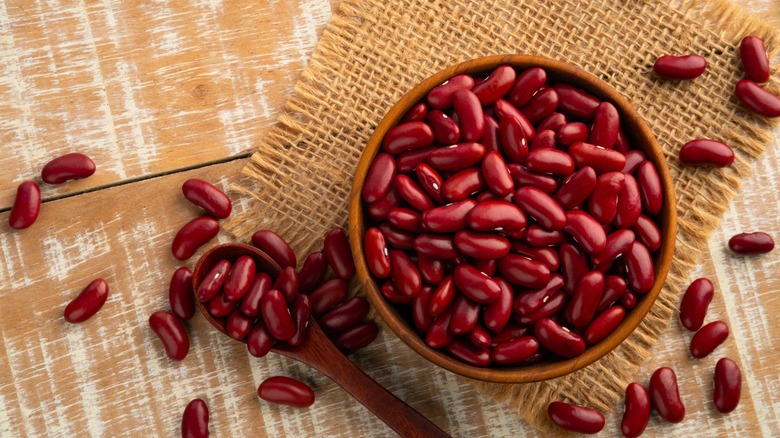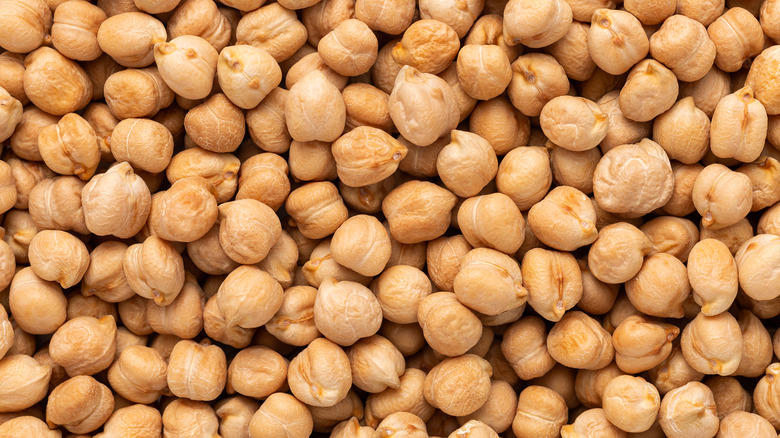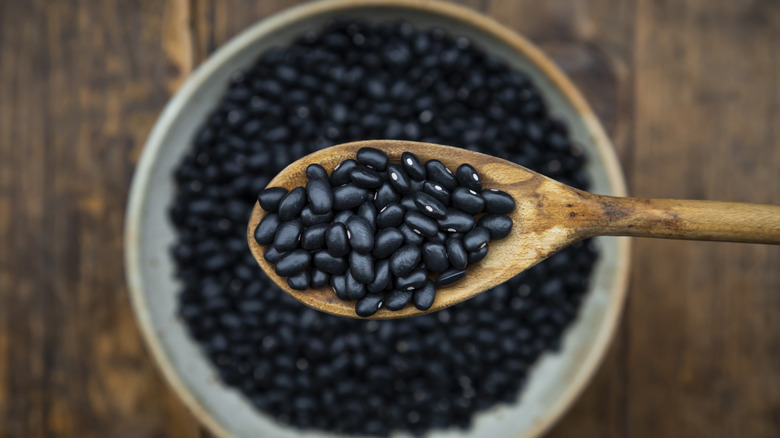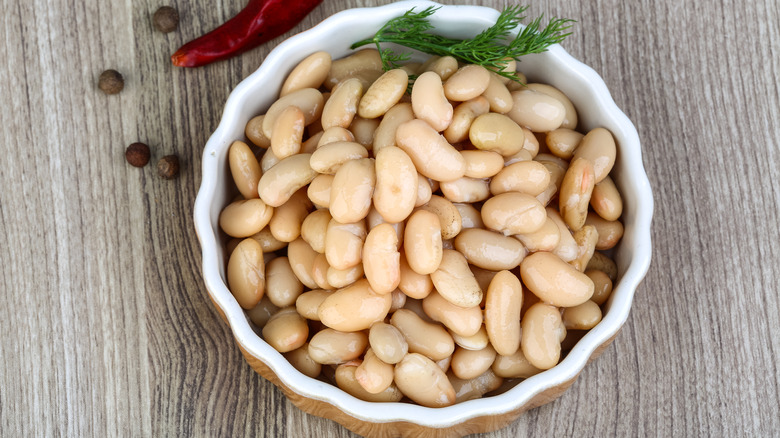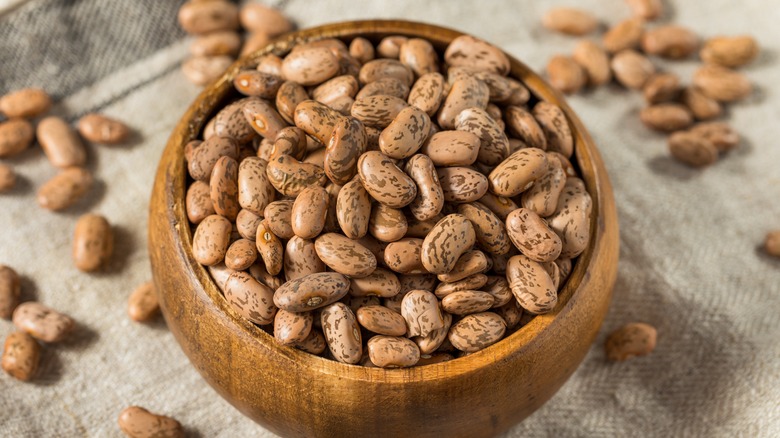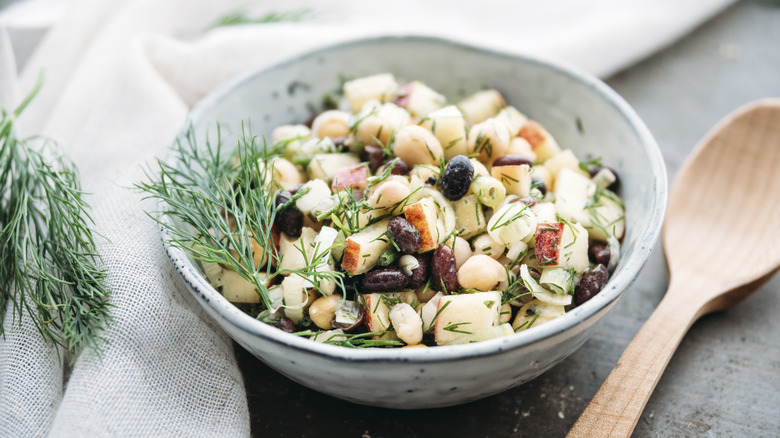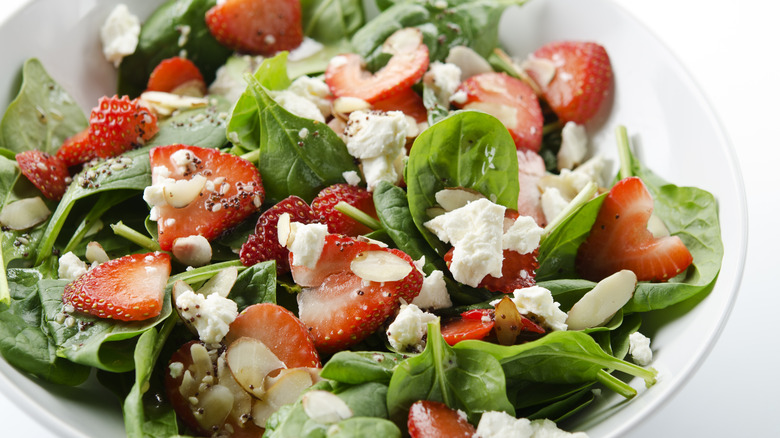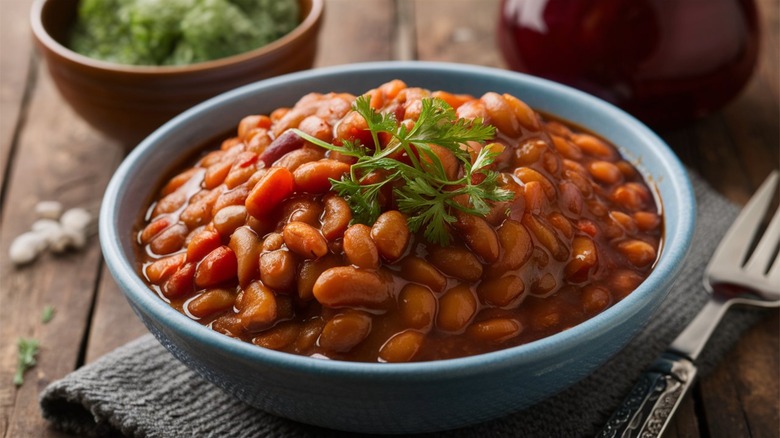The Best Beans To Use In Salads, According To Culinary Experts
Adding beans to your salad is a great way to add some variety. It is a wonderful option in both the summer, when salads are full of fresh, seasonal produce, and in the winter, when you might need to bulk up your salad intake. But which beans are best, and how do you use them? Luckily, we asked a few experts to help answer these questions.
We spoke to Sarah Hill, who is a food blogger and recipe developer for Real Food with Sarah. She specializes in quick, family friendly recipes. Also a certified nutritionist, Hill gladly lent her expertise and advice. We also spoke to Yumna Jawad, who is a recipe developer, cookbook author, and the founder of Feel Good Foodie. She specializes in unique but simple recipes which she shares with her large following. Jawad has been featured in Vogue, People, and the New York Times, to name a few, and her first cookbook was released in May of 2024. Finally, we spoke with Jessica Gavin, a certified food scientist and recipe developer at her eponymous food blog, Jessica Gavin. Gavin loves balancing flavor with science. With the help of these three culinary experts, we now have a great idea of what beans go well in salads and how to use them for the best outcome.
Why add beans to your salad?
There are many reasons to add beans to your salad. The first is that they are simply delicious and their flavor lends itself well to many salads. On top of that, however, they also add many nutritional benefits; Sarah Hill told us that "beans add protein, fiber, flavor, and texture to salads." This added fiber and protein is not only good for you, but it helps keep you full for longer, which is especially important if your salad makes up the entirety of your meal. Yumna Jawad added that beans are full of vitamins and minerals, and that they are great for digestion, while Jessica Gavin noted that they are great for muscle health. Hill also said that adding beans means you don't need to include animal protein in your salad, if you don't want to.
There is something to be said for the additional texture that beans provide in a salad. "Beans add texture to salads that can offset the monotony of leafy greens and raw vegetables," Jawad told us. "Depending on the type, they can be creamy, firm, or slightly crunchy." This can be a huge plus, especially if you are not the kind of person who loves munching on lettuce. Gavin said, "The diverse types of beans offer unique tastes and textures, enriching the overall salad experience," which in itself is probably enough of a reason to add beans to your salad. So, what kind of beans should you use?
Kidney beans
Both Jessica Gavin and Yumna Jawad recommended adding kidney beans to your salads. Jawad said that "kidney beans have a somewhat firmer meatier texture to them," which makes for a great addition to salads that are lacking that meatiness. For example, Gavin recommended adding kidney beans to Italian-inspired salads, such as one with "arugula or romaine, vine-ripened tomatoes, fresh mozzarella, Parmesan, and balsamic vinaigrette." You can also make kidney beans a more central element of your salad, as is the case in this celery and kidney bean slaw-style salad.
This large, red bean gets its name from its resemblance to the kidney. From Central America and Mexico, the kidney bean is a staple of many cuisines from that region. Throughout time, however, it has become a popular bean all over the world. Like most beans, kidney beans are rich in protein, boasting almost 9 grams of protein per 100 grams of cooked beans. They are also high in fiber, in addition to being rich in many vitamins and minerals.
Chickpeas
Chickpeas are a classic salad ingredient, and our experts agree. Yumna Jawad likes that chickpeas have a "slight bite" to them, whereas Sarah Hill told us, "I will typically reach for chickpeas because they have a great nutty flavor." Jessica Gavin also noted that they have a delicious, nutty flavor, adding that this makes them great for hearty salads. Hill will add chickpeas to Mediterranean chopped salads and orzo salads, two delicious and filling ideas. Alternatively, you can try making this creamy, sweet, and hearty sweet potato salad with chickpeas. Another idea for adding chickpeas to your salad is to roast them until they are crunchy; Gavin told us that this hack is one of her favorite substitutions for croutons.
First popping up in the Middle East approximately 7,000 years ago, chickpeas are popular in Middle Eastern cuisines. Like kidney beans, chickpeas are high in protein, boasting about 15 grams of protein per cup of the bean when cooked. They are likewise high in fiber, and full of vitamins and minerals like zinc and iron.
Black beans
Black beans are another common staple bean. They are soft in texture, and were recommended for their use in salads by all three of our experts. "Black beans bring a rich, earthy taste that pairs well with a variety of ingredients," said Jessica Gavin. Both Gavin and Sarah Hill recommended using black beans in Southwestern or Tex-Mex inspired salads, due to the popularity of black beans in those cuisines. Gavin suggested combining black beans with "crisp romaine, bell peppers, and corn for a Tex-Mex or Latin-inspired dish," or "with shredded cheese, chips, and a protein-like grilled chicken for a more substantial entree salad." Check out this hearty taco salad for inspiration.
Similarly to kidney beans, black beans first appeared in South America and are commonly used in dishes in Latin America and the Caribbean. They can also help to control your blood sugar and reduce the risk of certain diseases like heart disease. They boast 15 grams of protein per cup of cooked beans, and are exceptionally high in fiber.
Cannellini beans
Cannellini beans are a soft, creamy white bean that is native to North and South America. They are perhaps most commonly used in soups and stews, although they definitely add a delicious element to many salads. Because they are one of several kinds of white beans, they are sometimes confused with navy beans or Great Northern beans; however, they are their own variety. Perhaps the highest in protein of all of the beans on our list today, cannellini beans have a whopping 17 grams of protein per cup of cooked beans. They also have a lot of fiber and a large serving of copper.
Jessica Gavin recommended adding these beans to your salads, telling us: "Cannellini beans have a creamy texture and mild flavor that complement many salad dressings." This is another bean that she will add to Italian-inspired salads, much in the same way that she might use kidney beans.
Pinto beans
The final variety of bean on our salad-friendly bean list is the pinto bean. These were recommended to us by Jessica Gavin, who said that "Pinto beans are a staple in my Southwestern salads, combined with corn, avocado, tomatoes, zucchini, and a zesty cilantro lime dressing." Pinto beans are oftentimes prepared the same way that black beans are, and the same is true when it comes to salads. They are also great in bean salads; check out our 12 ways to kick up your bean salads up a notch.
Pinto beans are traditional in Mexican cooking and are often used in many dishes in the United States. These beans were first discovered in ancient times in Mexico and Peru. While they are typically stewed or prepared as refried beans, there is no reason not to use this delicious and nutritious bean in your salads. They have 15 grams of protein per cup of cooked beans, as well as 15 grams of fiber and a large portion of iron.
What kind of salad should you add beans to?
While beans can be added to most types of salads, our experts had a few favorites that they recommended. Sarah Hill told us, "I love adding beans to quinoa salads, pasta salads, and taco salads to get more protein and fiber into my diet." These non-traditional salads lend themselves well to the addition of beans, especially because they are generally made up of smaller pieces of food than a traditional lettuce salad might be. Hill also mentioned quinoa and green salads as options.
Yumna Jawad told us that she doesn't like to eat beans with a fork because she finds it difficult, so she generally adds beans to salads that can be eaten with a large spoon. For example, she makes a Red Kidney Bean Salad that she loves, as well as a Southwest Quinoa salad, and a Mediterranean Chopped Salad. Another option is this great three bean salad.
Jessica Gavin listed quite a few salads that she loves adding beans to; Mediterranean salads with chickpeas, Southwestern salads with pinto and black beans, and Italian salads with cannellini beans. She also noted that beans are a great addition to creamy, protein packed salads, saying, "Beans can boost the fiber and protein content of creamy salads like chicken, tuna, or salmon as a filling for sandwiches, wraps, or lettuce cups."
Salads that don't work with beans
While beans are delicious in most salads, there are a few kinds that don't really lend themselves to the addition of legumes. For example, both Sarah Hill and Yumna Jawad recommended not adding beans to any salad that has fruit in it. "Their savory taste can clash too much with the sweet and juicy nature of fruits," Jawad told us.
Another category of salad that doesn't pair well with beans is any salad that has a distinct and unchangeable flavor profile. Hill gave the example of caprese salad, while Jawad spoke of Caesar salad, citing that she wouldn't want to disrupt its traditional flavor profile. Jawad also recommended not adding beans to salads that have a base of delicate greens, such as baby spinach, arugula, or mixed spring greens, because "the heavy dense nature of beans can overwhelm the light and airy texture of these greens." Jessica Gavin agreed, noting that watercress and frisée are overwhelmed legumes, which are heavy and dense compared to the lightness of the vegetables.
Types of beans that don't work in a salad
Just like there are salads that don't work with beans, there are also beans that don't necessarily work well with salads. Our experts gave us a few examples, starting with baked beans. "Baked beans are too sweet and loaded with sauce and may drown out a salad," Sarah Hill said. The same applies to refried beans, which are simply too mushy to work well in a salad.
Yumna Jawad told us that she avoids fava beans and lima beans in salads. She told us that fava beans have a tough outer skin that doesn't work well with something as delicate as a salad, whereas lima beans have too distinct of a flavor, thus overpowering a salad. Finally, Jessica Gavin told us that she avoids adzuki beans in her salads: "Adzuki beans are a small type of red bean that is slightly sweet and nutty. This makes them a better pairing for Asian desserts than a traditional salad." Instead, she opts for edamame in her Asian-inspired salads.
